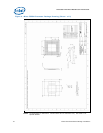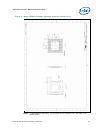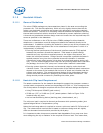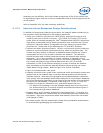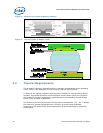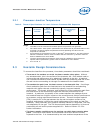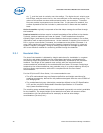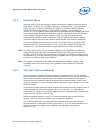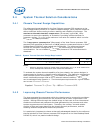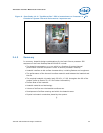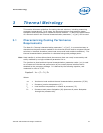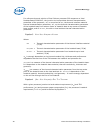
Processor Thermal/Mechanical Information
Thermal and Mechanical Design Guidelines 21
2.3.2 Heatsink Mass
With the need to push air cooling to better performance, heatsink solutions tend to
grow larger (increase in fin surface) resulting in increased mass. The insertion of
highly thermally conductive materials like copper to increase heatsink thermal
conduction performance results in even heavier solutions. As mentioned in
Section
2.1.2, the heatsink mass must take into consideration the package load limits,
the heatsink attach mechanical capabilities, and the mechanical shock and vibration
profile targets. Beyond a certain heatsink mass, the cost of developing and
implementing a heatsink attach mechanism that can ensure the system integrity
under the mechanical shock and vibration profile targets may become prohibitive.
The recommended maximum heatsink mass for the Intel Celeron processor 200
sequence reference thermal solution is 62 g. This mass includes the fan and the
heatsink only. The attach mechanism (clip, fasteners, etc.) are not included.
Note: The 62 g mass limit for current solution is based on the capabilities of reference
design components that retain the heatsink to the board and apply the necessary
preload. Any reuse of the clip and fastener in alternate or derivative designs should
not exceed 62 g. Designs that have a mass of greater than 62 g should analyze the
preload and retention limits of the fastener.
Note: The chipset components on the board are affected by processor heatsink mass.
Exceeding these limits may require the evaluation of the chipset for shock and
vibration.
2.3.3 Thermal Interface Material
Thermal interface material application between the processor die and the heatsink
base is generally required to improve thermal conduction from the die to the heatsink.
Many thermal interface materials can be pre-applied to the heatsink base prior to
shipment from the heatsink supplier and allow direct heatsink attach, without the
need for a separate thermal interface material dispense or attach process in the final
assembly factory.
All thermal interface materials should be sized and positioned on the heatsink base in
a way that ensures the entire processor die area is covered. It is important to
compensate for heatsink-to-processor attach positional alignment when selecting the
proper thermal interface material size.
When pre-applied material is used, it is recommended to have a protective film
applied. This film must be removed prior to heatsink installation.
The recommended TIM for the Intel Celeron processor 200 sequence reference
thermal solution is Honeywell PCM45F (pad version). It is not recommended to use
TIMs such as thermal greases onto small bare die package as specified in
Section
2.1.2.1.




